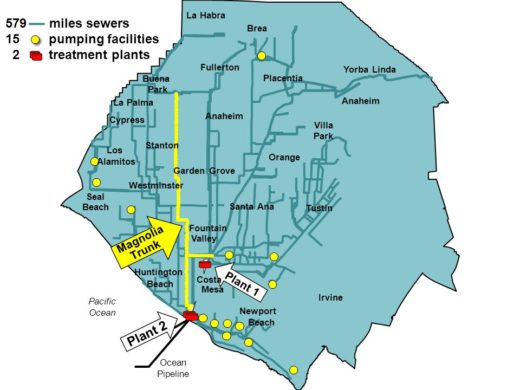
Photo provided by Orange County Sanitation District.
By Benjamin Minch, Staff Writer
As many can smell, there is an ongoing stench coming from the storm drains near the bowl. As noted in a previous article, The Morning Stench of Fountain Valley, this stench is most likely coming from the drainage system at the pond at Mile Square Park. There may be more to the problem however, and to find the answer we must dive deeper than the surface: into the sewer itself.
I was able to find a map of the Orange County sewage system showing all of the pipes, pumps and treatment plants in the region. According to the map, it seems that the epicenter of almost all of the sewage pipes is right next to Fountain Valley, in plant 1. On top of this, there is a sewage pipe that runs directly beneath our high school. To properly use this data however, we must first learn the basics of how a sewer system works.
First, sewage from houses, schools, ponds and just about every other place pour into the sewage pipes. This sewage then proceeds to flow down the pipes all the way to the nearest treatment plant. In this plant, solid material is separated and then organic material is consumed by bacteria. The water is then chemically tested and nitrogen and phosphorus are removed. Then, it is deposited into the ocean. Only around 90% of the water is clean, however.
So breaking down the process, we can see that most of all the sewage in the entire county flows through the pipe that goes directly under Fountain Valley High School. This means that our smell could be attributed to anything in our sewage system because the water is untreated. The same pipe however, does connect our school to Mile Square Park, validating my last hypothesis.
This smell is a large problem, and will continue to be a large problem in the future because of the unfortunate location of FVHS. There will always be sewage, so there will always be a stench.
The bigger problem however, is that everything we dump in our storm drain, has the opportunity of making it to the ocean and destroying wildlife. Knowing that only 90% of the water is filtered means that 10% is seeping into the ocean, which can make a huge impact. This excess nitrogen and phosphorus, which are referred to as limiting resources because when they are present there is immense growth, causes algal blooms. These algal blooms off our California coast were responsible for the deaths of over 100 sea lions last spring. This is because the toxins produced from these algae are being eaten by fish, which are then being eaten by sea lions. The start of the problem is runoff into sewers.
Knowing these catastrophic effects, students should be more cautious of what they are dumping into the storm drains, as they have the potential to do immense damage.





